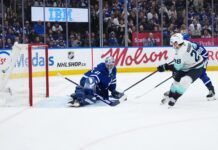The Ilya Lyubushkin acquisition quickly overshadowed a mostly forgettable and not particularly well-played 4-2 victory by the Maple Leafs over the Arizona Coyotes.
Let’s jump into a modified Game in 10, starting with some first thoughts on the trade.
I’ll start by saying that I must be careful comparing actual trades to hypothetical trades. What was the specific asking price from Craig Conroy that Brad Treliving would’ve needed to meet to win the Chris Tanev sweepstakes over Jim Nill in Dallas knowing Treliving did not have second-round picks available? We need to know this information before making any concrete judgments.
After sizing up the Dallas-Calgary deal (2nd, cond. 3rd, and an okay prospect), I can picture a version of the Leafs trading a first-round pick and a prospect for Tanev, getting back a mid-level draft pick in the deal, and deciding the gap in ability between Tanev and Ilya Lyubushkin (it’s large) is worth the difference in the aggregate pick/prospect value (e.g. keep the third and sixth, the first goes out, and Calgary’s — let’s say — third or fourth comes in alongside Tanev).
One player moves the needle in terms of a quality top-four D while also checking every box regarding the team’s needs (PK, right shot, credible shutdown D vs. top matchups). The other fills a gap so that the defense at least isn’t a complete misaligned mess. But I don’t know what the specific price was to seal the deal on Tanev to Toronto, and we don’t know yet what moving lesser assets for a double-retained ($685,000) Lyubushkin could free the Leafs up to do elsewhere.
If my hypothetical option was on the table, I can’t totally sign off on Treliving’s decision here. But it’s a lot of ifs. Lyubushkin will help, but he’s a rental and it’s fair to wonder if he budges the needle much. Watching the Leafs roll out Benoit-McCabe and Brodie-Liljegren with success during the recent winning streak does lend credence to the idea that just a competent righty of any kind — one with some history of reasonable chemistry and results with Rielly — could instantly help elevate the D core into better-than-the-sum-of-its-parts territory, and the net effect could be a notable improvement over trotting out Lagesson on Rielly’s right or rejigging all of the pairs into total uncertainty/disarray.
As Anthony put it in a conversation tonight, “Marc Staal was in Florida’s top four during their Cup Finals run. None of us know anything.”
They led 1-0 after 20 minutes, but the opening frame of this game was an unserious period of hockey from the Leafs (so was most of the third). The period was played at preseason intensity, and they gave up a bunch of odd-man rushes against; on one such instance five minutes into the game, Marner turned it over high in the offensive zone and then decided to drop to his knees in the neutral zone in some sort of soccer style move (seemingly for fun/out of boredom?), subsequently giving up a 2v1 behind him. This is not to pick on Marner, though; the Leafs lost F3 a number of times for odd-man rushes against, they weren’t digging in on backchecks, they were too often slowly deliberating and reloading in their own zone on breakouts with little urgency, and they didn’t get enough pucks to the net in the offensive zone.
Even the 1-0 goal wasn’t particularly serious — a laughable turnover by the Yotes at the offensive blue line and a Marner breakaway drop pass for a Matthew Knies goal. It didn’t work against Vegas, but it’s always pretty if it does.
Give credit to Ryan Reaves for finishing a hit, dropping the gloves with O’Brien, and nearly banging in a goal in front at one point in the first period. It brought a notable spark to a flat team in a quiet building. It is also a big difference when it comes from a player who is actually contributing in the run of play as part of a fourth line that can consistently win shifts (versus getting regularly tilted, actively hurting momentum for the team but finding a fight to try to justify your existence in the lineup).
"DOWN GOES O'BRIEN!"
REAVES VS O'BRIEN courtesy of Joe Bowen and Jim Ralph. #LeafsForever @Bonsie1951 @Jim_Ralph @LeafsJelly
2/29/2024 pic.twitter.com/b6g2j0Y3e6
— Maple Leafs Hotstove (@LeafsNews) March 1, 2024
The Leafs clearly weren’t taking the competition very seriously tonight — which they can get away with against Arizona, and they did, although just barely in the third period (26-8 shot attempts and a goal against to make it 3-2). In the final frame, they mostly stood around and did the bare minimum of protecting the house while eating zone time against, not showing much appetite to dig in, tilt the ice the other way, and put the game to bed. Joseph Woll was sharp early and throughout the night — much better than he should’ve needed to be in the circumstances — which in the big picture is the most important takeaway from the game.
I am no goalie expert, but I rate Woll’s talent level really highly and believe a healthy Woll raises the ceiling for this team more than is perhaps fully appreciated in the market, where so much of the attention — when it comes to taking the Leafs over the top for a deep playoff run — is centered on improving the team’s blue line. He is legitimately capable of stealing games, and he’s so efficient and quiet in the net that it has a notable calming effect on the team. He just has to stay healthy.
There was only really one segment of the game that involved the Leafs truly dominating a string of consecutive shifts and tilting the ice, which came in the second period when Keefe threw the lines in a blender and put Mitch Marner on defense with Mark Giordano out.
I am not going to read too deeply into Marner on defense other than to say, on this team, it really stands out in terms of the possibilities it opens up when they have a talented problem solver with the puck breaking it out from deep in the d-zone and a skilled operator at the offensive blue line creating seams and scrambling defenders. Big picture, looking ahead to the offseason and beyond, this team needs to prioritize finding a defenseman with some poise and dynamic skill with the puck (someone not named Rielly). This is also why I always understood the Klingberg shot in the dark even if it came up empty.
Morgan Rielly’s ill-conceived gamble for the 3-1 Arizona shorthanded breakaway goal by Alex Kerfoot brings up a worthwhile discussion point about the team’s power play.
I don’t want to downplay the fact that it has been really good for most of the year or that the overall percentage sits at the top of the league (or did before tonight). But it is worth mentioning that the percentage is also currently overstating the PP’s overall impact on winning games because of two factors combined: their lack of power-play opportunities, and the number of shorthanded goals they concede (often through sheer carelessness with or without the puck).
They’re now tied for the second-most shorthanded goals against with eight this season. As a result of the lack of power-play opportunities, they’re sixth in total goals for on the power play, and because of the shorthanded goals against, they’re actually ninth in the NHL when it comes to goal differential on the power play.
It’s partly mitigating what should be a huge strength of the team. After years of the Leafs sitting near the bottom of the league in power-play opportunities, that part probably isn’t changing substantially. But the shorthanded goals against is something they can and need to address.
I am going to include this passage from Anthony from last spring about the importance of proper handedness, particularly at playoff time:
One thing that gets underplayed every season but seemingly becomes important every playoffs is defense handedness. If you look at the final four teams, they all generally run three left-hand shots and three right-hand shots, with the one exception being Shea Theodore, who has some high-end skill to his game.
In the regular season, you can get by on your off-side. The checking is not as tight, teams are not game planning as well for opponents and there isn’t as much detail to the game. At least a third of the league is not particularly good either, giving you easier games with more time to make plays.
Last year’s Stanley Cup final followed the same pattern. The Avalanche dressed three lefties and three righties the entire playoffs. The Tampa Bay Lightning generally dressed three right-handed shots as much as possible, the problem being their options beyond Erik Cernak, Zach Bogosian and Jan Ruuta were not exactly guys you could trust at the top of your lineup. This playoffs, the Panthers and Hurricanes have only dressed three lefties and three righties. The Stars have tried but Colin Miller and Jani Hakanpaa, both dependable righties, have given them no choice at times.
Ultimately, when you are playing on your off-side, everything just takes a second longer — for example, taking a D-to-D pass, rotating your hips and turning your body up ice to make a transition pass. Off the rush, it is also easier for attackers to drive wide. A defenseman can’t follow you with his stick when he’s defending on his off-side because he has to bring it all the way across his body.
Look at this example between Golden Knights forward Keegan Kolesar and Stars stud Miro Heiskanen. When Kolesar drives wide, Heiskanen initially waves his stick and once he misses, he has to regather himself which allows the Vegas forward an extra second of time and space to cut in and get position on him. At that point, it’s already over. Heiskanen can’t recover.
In the playoffs, we see guys play higher up in the lineup than maybe they should in part due to handedness and we see players get moved back to their strong side because they are otherwise struggling — like the Leafs did with TJ Brodie. It is very difficult to play on your off-side in the playoffs and year after year the teams that go far generally have an even distribution on the backend.
A lot of attention is placed on possession plays, but the first 10 seconds of the third period when TJ Brodie got roasted by Nick Bjugstad is an example of the extra level of difficulty the offside can introduce when defending a drive wide off the rush (especially for a player who has lost half a step this year in Brodie).
I’ll be curious to see the team with two righties in the lineup along with a lefty who is taking to the right quite well in McCabe.
After seven goals in his first 28, Nick Robertson currently has one goal in his last 13 games. His 15:11 of ice time tonight was the most he’s played in those 13 games, but he battled a collection of rough shifts tonight when it came to managing the puck on the breakout in the defensive zone. It probably doesn’t receive enough attention that he is a rookie playing his off-wing in the league. It’s really not ideal.
Sheldon Keefe has used the reset of the press box before to good effect with him this season. Calle Jarnkrok would take his place if he was ready to go on Saturday, but the only other option until Jarnkrok is back (if they’re sticking with the balanced look) is asking Tavares to play with Noah Gregor and Bobby McMann. I am surprised they haven’t flipped McMann and Robertson more often, at a minimum, especially knowing McMann has spent some shifts there in a fourth-line capacity. McMann is stronger on the walls, and with his size and speed, he’s capable of driving defensemen wide on his backhand.
Funny to note: Tyler Bertuzzi, scorer of tonight’s game-winner on a nice tip to give him five goals in his last three games, would actually be on a 20-goal 82-game pace if he didn’t sail an empty-netter over the net in St. Louis at the end of the game on Feb. 20 or hit the post on an empty-netter tonight. Huge for the Leafs that he’s now scoring on goalies, though.
Tyler Bertuzzi 12th of the Season vs Arizona Coyotes courtesy of Joe Bowen and Jim Ralph. #LeafsForever @Bonsie1951 @Jim_Ralph @LeafsJelly
2/29/2024 pic.twitter.com/RzUOSElyN1
— Maple Leafs Hotstove (@LeafsNews) March 1, 2024
Most importantly, here’s hoping Mark Giordano is okay. The couple of weeks he just experienced is completely unfair to one of the most respected pros in the game.














![John Gruden after the Leafs prospects’ 4-1 win over Montreal: “[Vyacheslav Peksa] looked really comfortable in the net… We wouldn’t have won without him” John Gruden, head coach of the Toronto Marlies](https://mapleleafshotstove.com/wp-content/uploads/2025/09/gruden-post-game-sep-14-218x150.jpg)




















